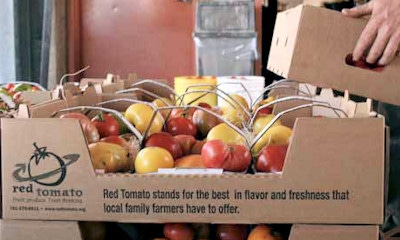
USDA Farm Service Agency is taking the lead on a meeting April 28 in Missoula that's drawing officials from a number of groups within USDA to provide information on the idea of the Food Hub. The event starts at 8:30 a.m. and ends at 12:30 p.m., and will be held at the Missoula County Extension Office (see details at the end).
This event had us wondering what a food hub was, and if we're asking readers are too. What follows is a short explainer of a food hub and what value they can bring to a region or community.

Branding - like this Red Tomato case - is one option to consider to help promote and support the local and regional food hub.
In a helpful - but long - 92 page document USDA's Agricultural Market Service lays out a number of details about food hubs and what they can do. This is definitely going beyond the local food shelf, and creating a direct connection to local and regional food producers. The classic definition - according to USDA - is "a centrally located facility with a business management structure facilitating the aggregation, storage, processing, distribution, and/or marketing of locally/regionally produced food products."
Of course food hubs can take on many forms, including some that run their own community gardens to bulk up their supply of fresh fruits and vegetables, but essentially the key word is "business management structure" which helps grow the food hub and is designed to maintain the hub's financial viability.
USDA offers these defining characteristics of a Regional food hub, noting that these systems are defined less by a particular business or legal structure, and more by how their functions and outcomes affect producers and the wider communities they serve. Defining characteristics of a regional food hub include:
• Carrying out or coordinating the aggregation, distribution, and marketing of primarily locally/regionally produced foods from multiple producers to multiple markets.
• Considering producers as valued business partners, instead of "interchangeable supplies and is committed to buying from small- to mid-sized local producers whenever possible.
• Working closely with producers, particularly small-scale operations, to ensure they can meet buyer requirements by either providing technical assistance or finding partners that can provide technical assistance.
• Using product differentiation strategies to ensure that producers get a good price for their products. USDA lists ideas for product differentiation strategies including identity preservation, group granding, specialty product attributes and other marketing tools.
• Aiming to be financially viable while also having positive economic, social and environmental impacts within their communities, demonstrated by carrying out certain production, community or environmental services and activities.
The food hub can help solve the problem of food deserts, which USDA is working hard to overcome. A blog post from several years ago from USDA helps put this into perspective and little has changed today.
Missoula event - more details
If you're interested in knowing more about the Montana effort, plan to attened, April 28 at the Missoula County Extension Office at 2825 Santa Fe Ct. #1 in Missoula. The meeting is free and open to the public. The informational meeting is hosted by the Lake County Community Development Corporation of Ronan & Community Food and Agriculture Coalition of Missoula County, in partnership with USDA.
For more information about the meeting, please contact Jan Tusick at [email protected] or 406.676.5901, Annie Heuscher at [email protected] or 406.830.8218 or Jennifer Cole at 406.587.6786 or [email protected].
About the Author(s)
You May Also Like




